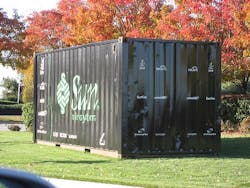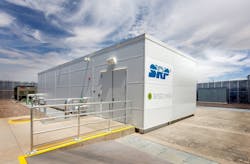The Past, Present and Future of Modular Data Centers
In this week’s Voices of the Industry, David Shepard EVP, General Manager of the BASELAYER’s Anywhere hardware division, looks over the past, present and future of modular data centers.
DAVID SHEPARD, BASELAYER
In honor of the upcoming holidays, we would like to bring out our inner Ebenezer Scrooge to consider modular data centers of the past, present and future.
Past:
The first modular data centers (MDC) were deployed almost a decade ago. These units were initially focused on a portability and rapid deployment; an example is seen below by Sun Microsystems (now Oracle).
The deployment model was primarily limited to an ISO (shipping) container with an external chiller and supplemental power. At the time, there was not much thought put into software integration or network latency, rather just a focus on storage and computing needs.
An early model of the Sun Microsystems “Black Box” IT container.
Major IT equipment vendors created MDC’s for various use cases. IBM launched a green initiative to reduce data center energy consumption. HP jumped in as well, with its POD (Performance Optimized Datacenter). HP also introduced Thermal Zone mapping in 2007, which reportedly helped to reduce energy costs by up to 45 percent.
All of this was a great start and a necessity to the growing demands of businesses and exponentially growing amounts of data being processed. It wasn’t until 2008 that a IO created their patented software defined modular data center, that a the market had a product that was agnostic to the IT infrastructure inside the unit and dedicated to the best data center infrastructure solution outside.
Present:
Modular data centers have come a long way in the last decade. From what was an ISO container focused on incremental energy savings and convenience of location, now has evolved into rapidly-deployed, right-sized, just-in-time pieces of Infrastructure technology. MDCs can now provide up to 1MW of critical IT power and cooling for up to 110, 52U racks in a single open floorplan. With breakthroughs in technology (and the right environmental conditions) you can use outside air to cool your modular data center if you want to save even more money and become increasingly energy efficient.
Today’s modular data centers are also driven by global infrastructure management software, take advantage of big data analytics, and meet a range of capacity requirements. Best of breed modular products are IT agnostic (pick your own IT hardware and cabinets), and in concert with the right software, can dynamically manage IT assets, cost optimize based on energy usage, and work with IT orientation engines to give users an unparalleled view of their critical infrastructure.
Today’s modular data centers are being installed at the edge of the network to give providers a scalable way to deliver content. They are also being deployed directly on the power grid to eliminate the need for components such as UPS or batteries (lowing the overall total cost of deployment).
Future:
In the Charles Dicken’s tale, Scrooge had insights into the future that caused him to change his ways for the better. While we do not have these same insights, there are several key market trends that should prepare Infrastructure and IT professionals for what is to come. According to Markets and Markets, the worldwide market for modular data centers will most likely grow from $8.37 billion currently to $40.41 billion by 2018. The Natural Resources Defense Council states that data center waste will rise from 91B kWh to 140B kWh by 2020.
These two trends together paint a future in which modular data center energy consumption will be a key factory. MDC providers will need to take an active part in their designs to continue to deliver performance while looking at the sustainability impact computing resources.
David Shepard is EVP, General Manager of the BASELAYER Anywhere hardware division. In this role, David is responsible all facets of the hardware business unit including sales, marketing, product development, manufacturing and customer service. Prior to his current role, Mr. Shepard was SVP of Enterprise Sales at both BASELAYER and IO Data Centers where he led sales and marketing initiatives most notably the development of IO’s Private Cloud product and delivery of data center as service to Fortune 100 companies. Mr. Shepard also worked as SVP Sales and Marketing for FORTRUST; a Colorado based data center colocation company. In his position, David led FORTRUST’s transition to modular data center deployments resulting in their current position as the market leader for the rocky mountain region. Shepard graduated from Arizona State University with a Bachelor of Science in Finance.





